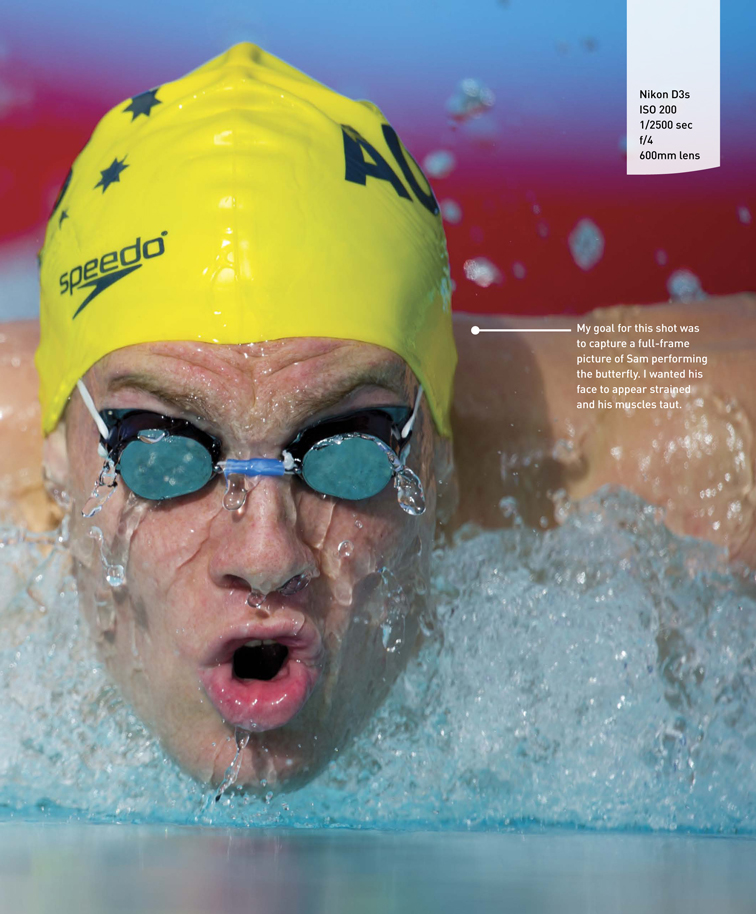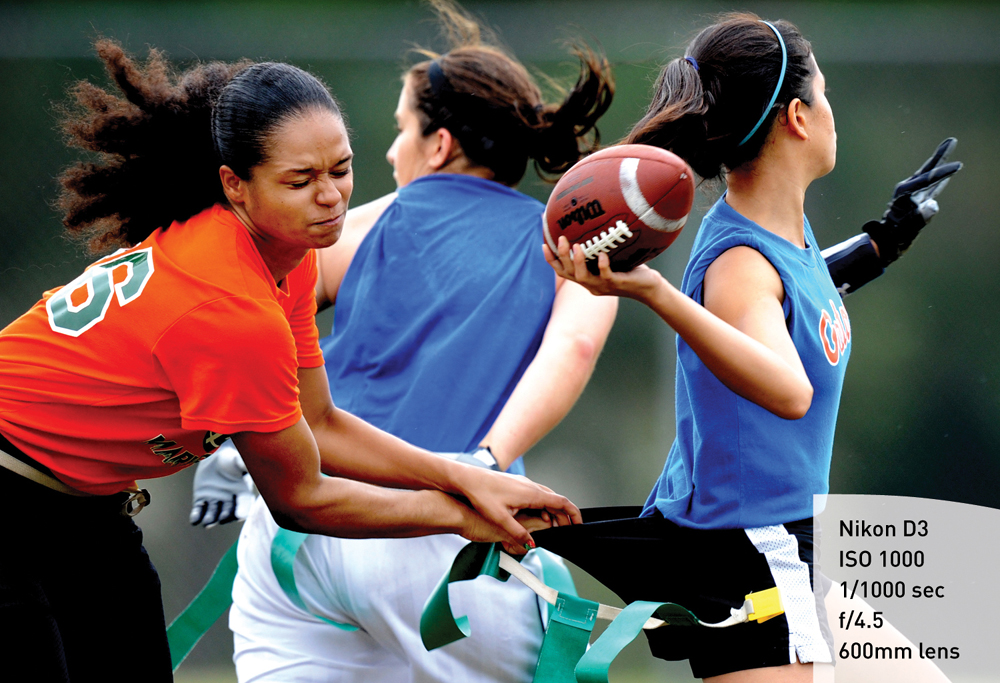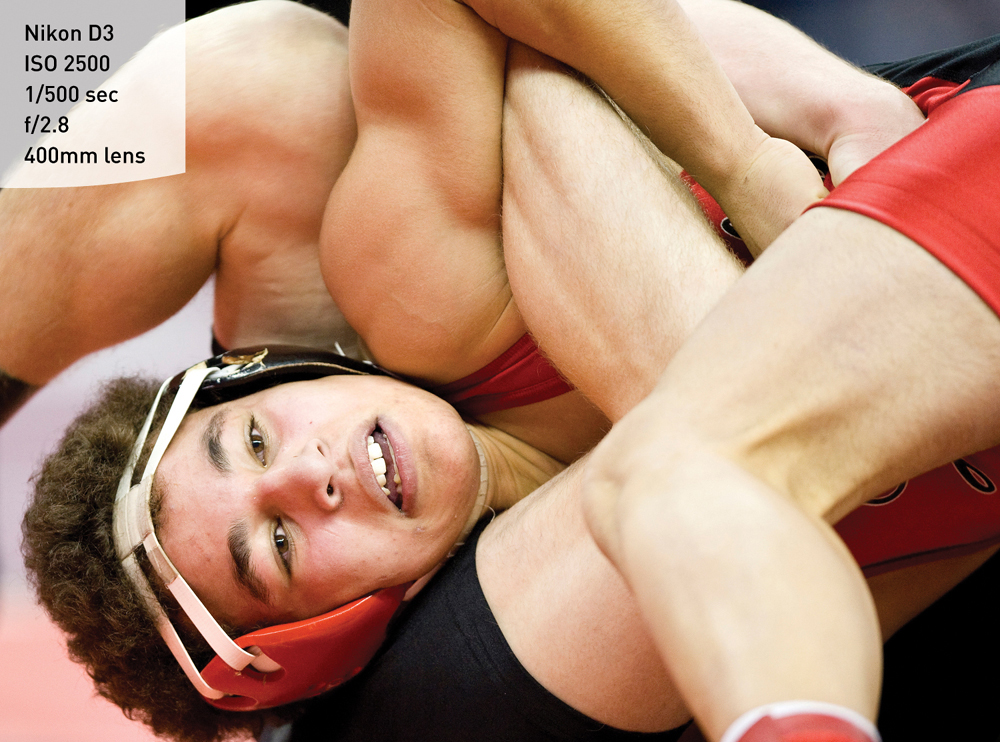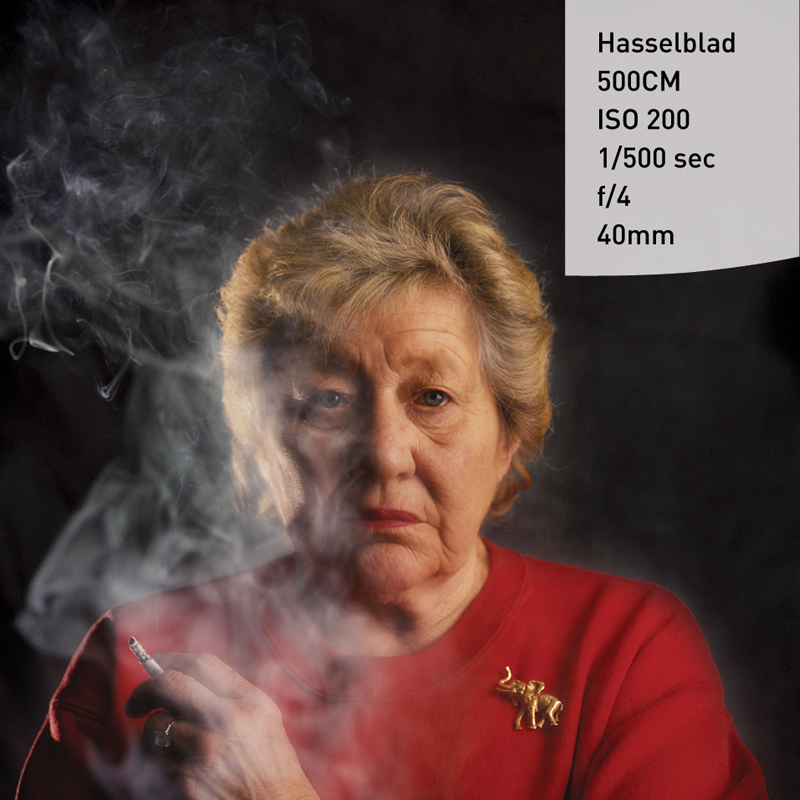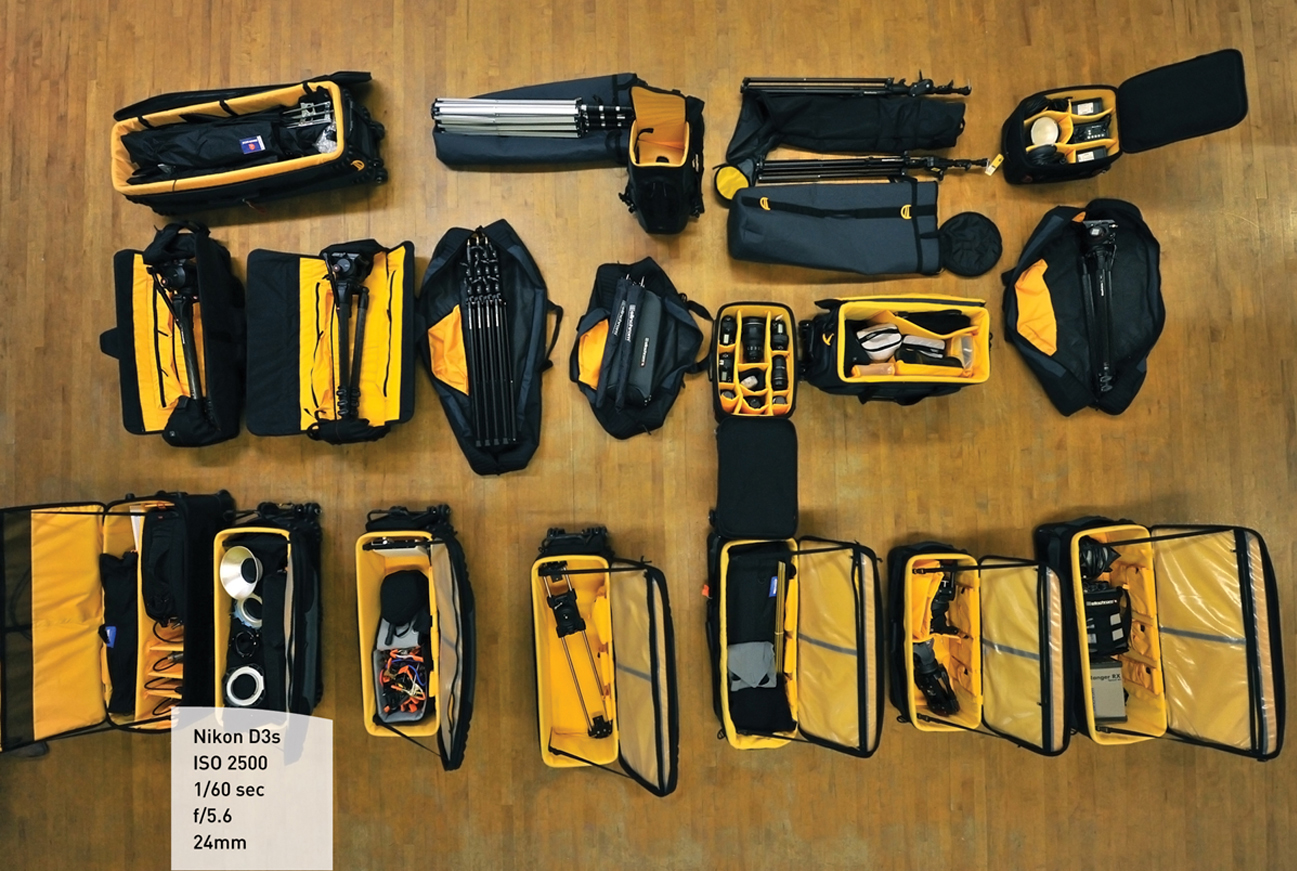1. In the Bag
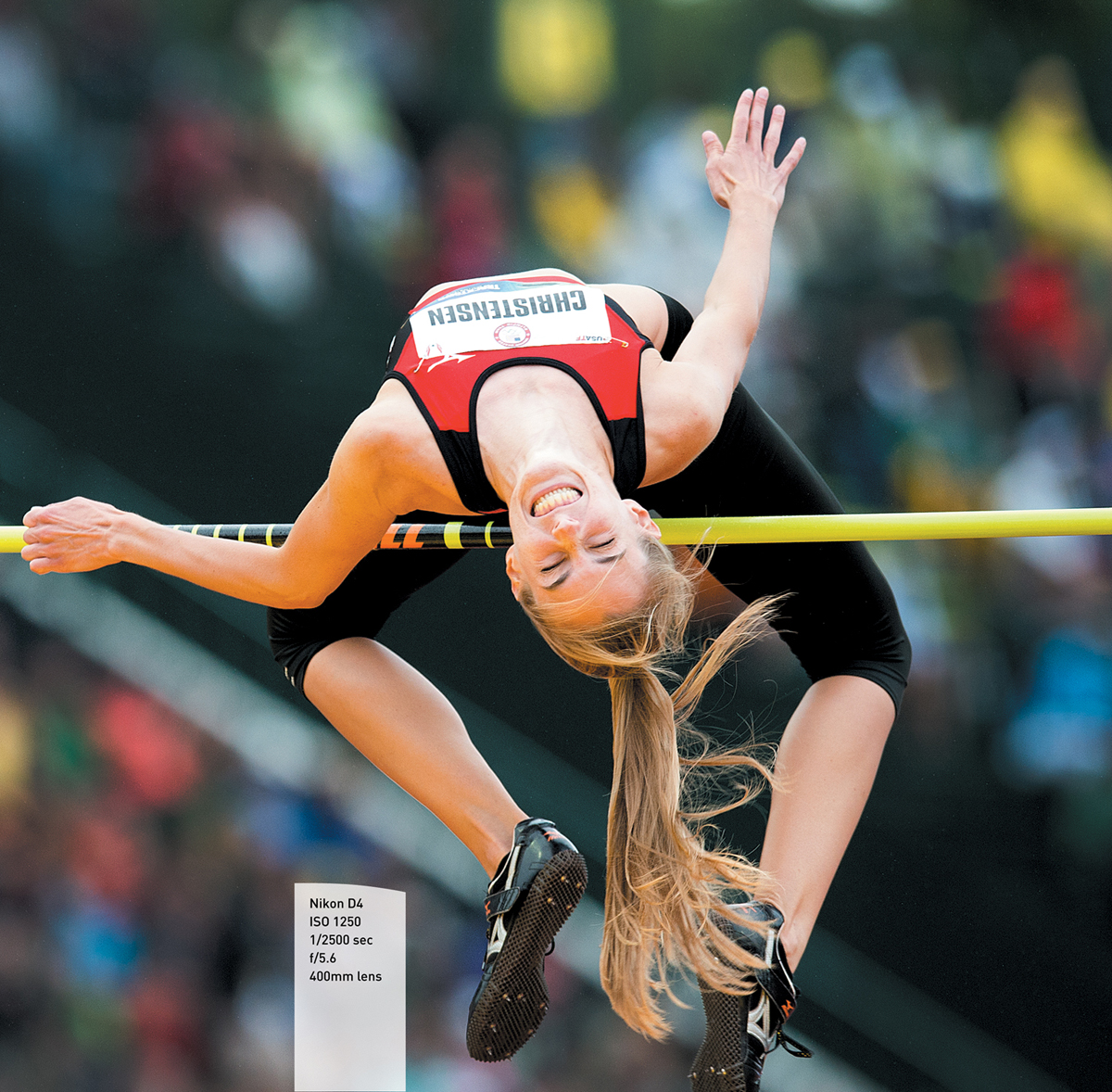
Rebecca Christensen competes in the women’s high jump during the 2012 USATF Olympic Trials. She finished sixth overall and did not qualify for the 2012 Olympic Games in London.
Equipment Essentials for Photographing Sports
I use my cameras and lenses like painters use their brushes.
Photography is writing with light. Sometimes you can control it, and sometimes you have to work so that it doesn’t control you. Having the right gear for the situation helps, but finding the right situation for the gear you have is just as important.
Poring Over the Picture

I shot this photo for the release of the Nikon D3s in 2009. We were in Melbourne, Australia, in the middle of July, which is the middle of winter in the southern hemisphere. It was very cold, just below freezing, the wind was blowing, and I was standing chest deep in the water. I had one of only four prototype D3s cameras hovering an inch over the cold pool as Sam, a former member of the Australian swim team, swam toward me.
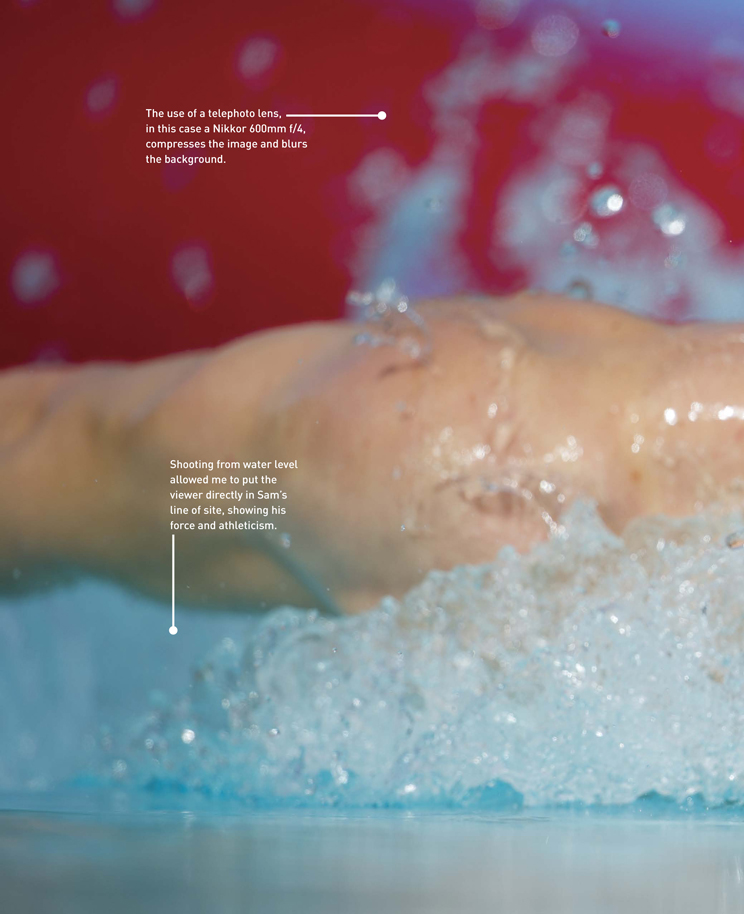
Gear Isn’t Everything
You can produce terrific images with any camera. How you go about doing that is the piece of the puzzle that is controlled by you and your photographic acumen.
At many athletic events, access is tightly controlled. This makes a photographer’s job more difficult but far from impossible. A number of factors influence access:
• The safety of the athletes and the spectators.
• The sanctity of the competition—not interfering with the game being played or the people who are watching, and showing common courtesy.
• The ability of the facility to accommodate photographers given how much space there is to work in.
• Who owns the rights to take and use photographs and in what fashion (issues related to rights’ holders). This is not a universal concern but is increasingly an issue.
To some extent, access is important because it can dictate what’s in your bag. Unlike many other photographic disciplines, sports photographers are constrained to work in fixed positions, which means bringing the right gear in order to work within the limits imposed. Although no special access was needed to shoot Figure 1.1, I still had to be aware of my safety and those of the players. Because I could not be on the field with them, I had to have the right gear and shoot from a good location. I shot Figure 1.1 with a telephoto lens.
Sports photographers are notorious for being gear crazy. Although having certain pieces of equipment absolutely makes shots easier and better, it is important to remember that you make photographs with your heart, your mind, your eye, and your soul (Figure 1.2). The technical means necessary to take your vision and transfer it to a viewing medium where you can share it with your readers should be just an extension of those elements.
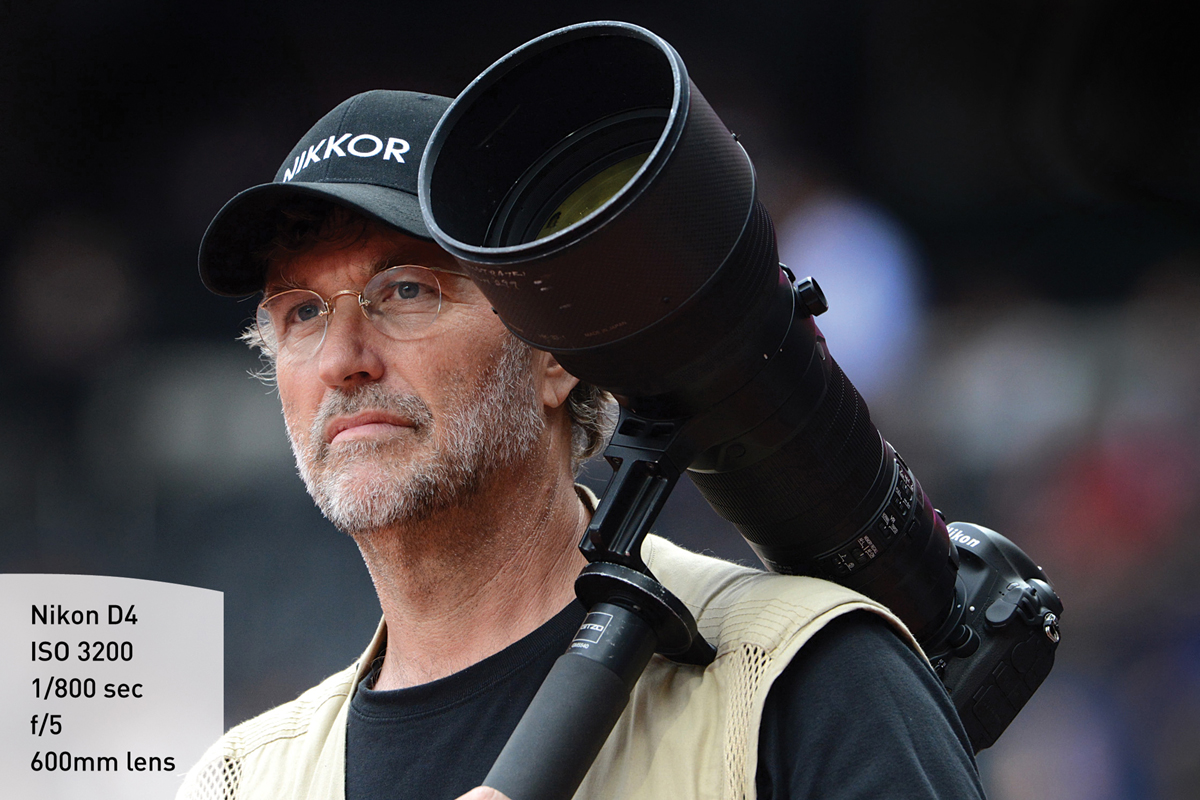
Figure 1.2 This image of me was taken by Laura Heald at the Olympic Stadium in London in August, 2012.
To make sports photographs, you need a camera, a lens, and a memory card.
Cameras
When you’re choosing a DSLR camera body, you have many options. The best cameras can run as much as $6,000. These cameras will have the biggest sensors and thus create the highest-quality images, and will shoot up to 11 frames per second. The more expensive the camera, the more bells and whistles it is likely to have. And although you can use all these features to do different, wonderful things, they are not necessary in every situation.
But don’t let the high price point of photo equipment scare you. Smaller, less-expensive cameras are also very good. The best camera for its price point is the Nikon D7000, which costs about $1,000. It handles low-light files well, shoots 6 frames per second, and gives you a large file to work with later (i.e., for post processing and printing).
My camera of choice is the Nikon D4. It is the biggest, most robust camera on the market. When I’m shooting for a publication like Sports Illustrated, I need to know the camera is going to react when I press the button and react the way I tell it to, so I invest in the best cameras I can find.
But I also use cameras like the Nikon D800, D600, and D7000 when I don’t need the speed of the D4. These cameras are smaller, more lightweight, and less expensive, and still produce multipurpose high-quality images that can be used across various platforms.
At football games I like to carry a small camera with a secondary lens on it for the type of photo you see in Figure 1.3.
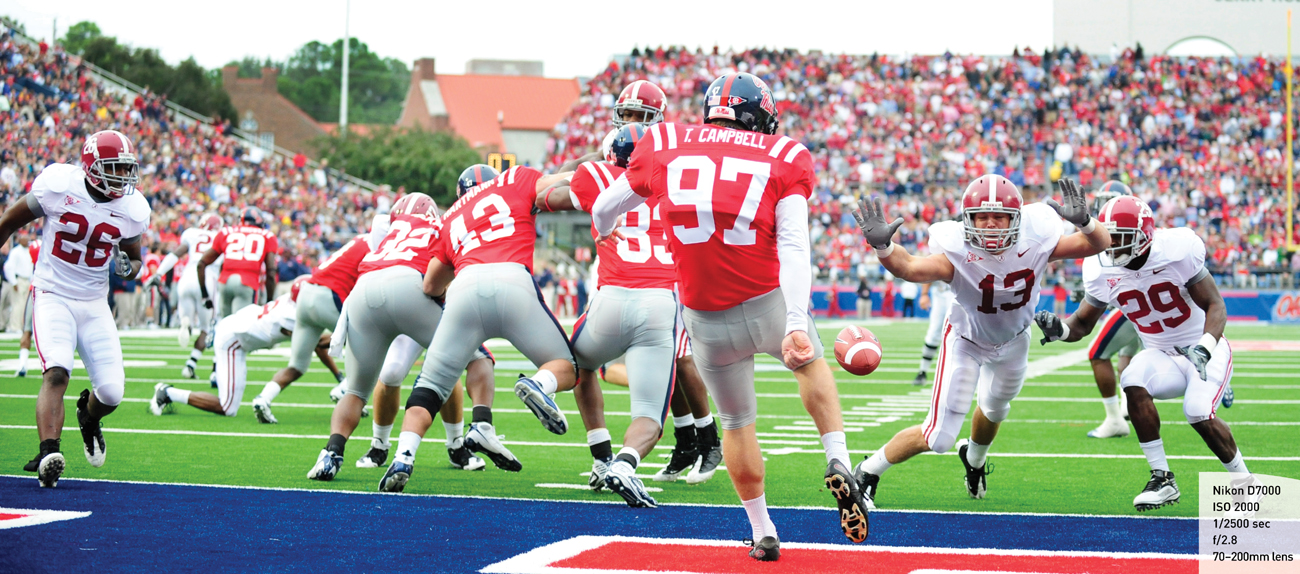
Figure 1.3 I knew Alabama would try to block a punt coming out of the end zone, so I was ready for it with my 70–200mm f/2.8 lens (set at 70mm) on my Nikon D7000.
Lenses
The camera is important, but equally critical is your choice in lenses. Part of the reason I shoot with Nikon cameras is that Nikon also makes some of the best optics in the world. Every sports photographer needs certain lenses, namely, a wide-angle and a telephoto lens. And the faster—meaning the lower the aperture setting, allowing more light to reach the sensor—the better. Lenses, like camera bodies, vary greatly in price and use.
Sports photographers live by their telephoto lenses. I’m a fan of prime lenses—fixed focal length—but those lenses tend to be more expensive than others. For a lower price point, the lens I recommend most is the Nikkor 70–300mm f/5.6. It is very sharp and offers a photographer a wide range of focal lengths.
The wide-angle lens is used less often but can still be very important to a sports photographer, especially in the context of a story. For some events, like the discus throw, I like to use a wide-angle lens to show the environment. In the photo in Figure 1.4 the net is important, so I used the Nikkor 14–24mm f/2.8 lens. However, you have several options in this range.
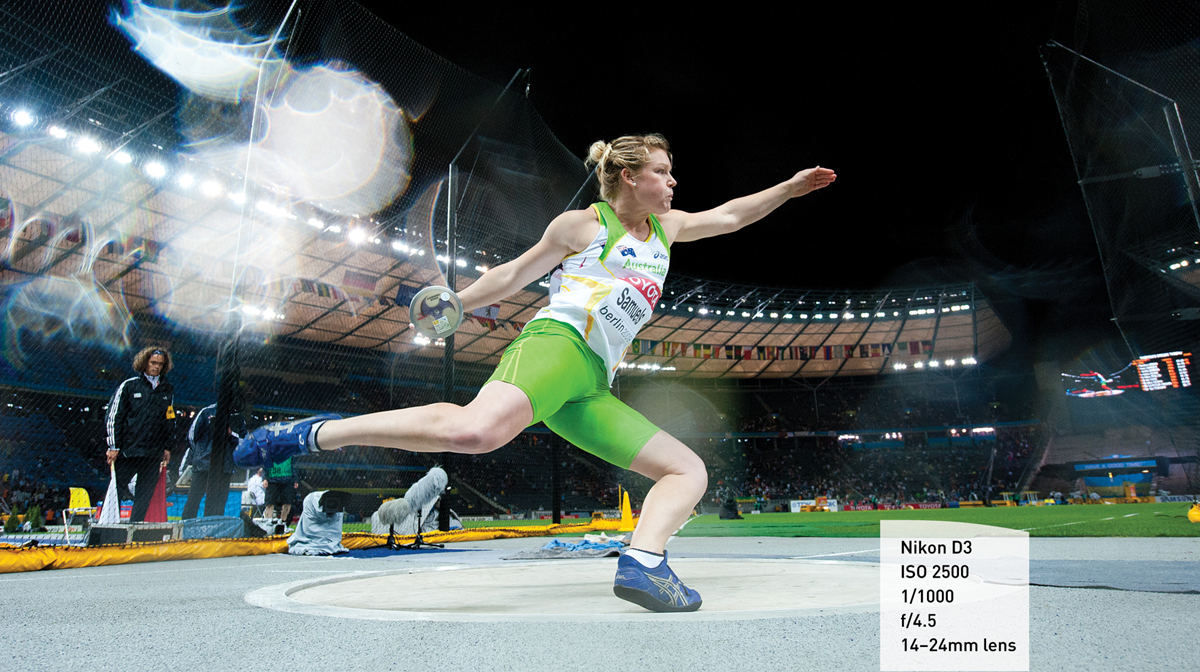
Figure 1.4 The wide-angle lens allows viewers to see the stadium and the discus thrower’s form, and the flare on the left side of the frame shows you it was wet outside.
The most popular lenses for sports photographers include:
• 14–24 f/2.8
• 16–35 f/2.8
• 24–70 f/2.8
• 70–200 f/2.8
• 300 f/2.8
• 400 f/2.8
• 600 f/4
For the shot in Figure 1.5, I chose a telephoto lens so I could concentrate on the faces of the athletes.
Memory Cards
Memory cards are the equivalent of film in the digital age. Different cameras use different kinds of memory cards. Compact flash (CF) and SDHC are the most common types. However, the Nikon D4 is a new camera and with it you use a new kind of memory card, the XQD card. I always buy the biggest and fastest cards I can find—fast being the most important thing for me. When shooting sports, you are recording a lot of information in a short amount of time, and you want a card that can keep up. The faster cards are more expensive but earn their worth in the speed with which they record what you shoot.
Supports, Strobes, and Cases
The essential equipment in sports photography, or any type of digital photography, consists of a camera, a lens, and a memory card. But taking care of those cameras and lenses is just as important when you’re preparing to cover a game or setting up a portrait shoot. Investing in a few simple items will make the difference in how well your camera equipment serves your creative vision.
Supports
Many people forget to factor tripods and monopods into their gear. The common misconception is that supports are only necessary when you’re shooting at a low shutter speed. That is one reason, but it is not the only reason.
Tripods and monopods are used best as composition aids. I always have at least one monopod and one tripod with me everywhere I go. If I’m using a long lens, like a Nikkor 400mm f/2.8 or 600mm f/4, I’ll always have it on some kind of support.
A monopod is a must have for a sports photographer. Tripods are important as well, but most sidelines do not allow tripods for safety reasons. I use tripods mostly for remote cameras or when I’m shooting video.
Monopods and tripods aren’t the only support equipment you can use. There is a plethora of grip gear and smaller supports I’ll discuss later when I break down how I cover each sport.
Strobes
Strobes, or electronic flashes, are also an important accessory for a sports photographer. But you can’t use strobes for every sport; not every sport requires them, and some do not allow them at all. I mainly use strobes for portraits, basketball, and hockey.
For the most part, I use big, powerful strobes so I have as much control as possible. I mainly use strobes in portrait situations when I direct the athletes and the shoot. Using extra light to knock down a background or accent a feature of their body that is unique, attractive, or an important part of their persona helps take my portraits to the next level. In Figure 1.6, a portrait of Marge Schott, I used dramatic lighting, the subject’s pose, and the smoke from her seemingly omnipresent cigarette to emphasize her toughness.
Cases
How you pack your gear is ultimately important to achieving good results in your final product. When I show up to an assignment, I need to be confident that my equipment will work as soon as I arrive. The best way to ensure that happens is to pack it properly.
The camera gear can only produce the results you allow it to produce, and upkeep is critical. Clean the lenses with soft cloths designed for that purpose. Have the sensors cleaned and the camera functions checked to be sure the autofocus is working properly, the sync speeds are correct, and the sensor is spotless.
Make sure to pack your gear securely for travel. To do this, I pack all my equipment—cameras, lenses, and supports—in Kata bags (Figure 1.7). The Kata Flyby 76 is my camera bag of choice because I tend to travel with a lot of equipment, and this bag allows me to bring it all and carry it safely. The Flyby 74 is a smaller option I frequently use as well.
To transport support equipment, like tripods and monopods, I use the Kata LW-99. It is lightweight but rugged and robust at the same time.
Having some sort of transporter to carry extra lenses, cards, and batteries while you’re on the field of play is also very important. Once you are on a sideline or a court it is not easy to leave, so you want to make sure you have everything you might need.
Some photographers like photo vests, but I prefer small waist bags. I find the more pockets I have the easier it is to lose something. The waist pack allows me to keep accessories in one, easily accessible spot.
Inside My Bag
When I go to a game or a portrait shoot, I pack seriously, and by most standards heavily, because my images will frequently be viewed by millions. But even if they weren’t, I would still want to have options when I’m shooting.
For most games, this is my minimum must-bring list:
• Four Nikon DSLR camera bodies (currently that includes three D4s and one D800)
• 14–24mm f/2.8 lens
• 24–120mm f/4 lens
• 200mm f/2 lens
• 400mm f/2.8 lens
• 600mm f/4.0 lens
• One Nikon SB 910 strobe
• Four PocketWizards (remote flash and camera triggers) with appropriate connectors
• Gitzo tripod with Manfrotto 409 head
• Gitzo monopod
• Sekonic Spot/Flash meter
• Sekonic Color temperature meter
• Lasolite tri grip
• Manfrotto Super Clamps and ballheads
• Manfrotto Poncho
• Lightware rain covers
• Gaffer tape
• SD, CF, and XQD cards
• Card readers
• Computers
I pack all this gear in Kata rolling cases and backpacks. Along with securely packing your gear, protecting your equipment from rain and other elements must be a priority as well. I realize that my camera options are more vast than most photographers’. Since I work for Sports Illustrated, I have to pack for every possibility.
If you only have one DSLR body, though, and want to be able to cover a sporting event, I would recommend bringing a zoom lens with that camera. My personal favorite zoom lens is the Nikkor 28-300 f/3.5-5.6. This lens is extremely sharp for the focal lengths it covers. The only downside is that it is a relatively slow lens, meaning the aperture values (f/5.6 at 300mm) force greater depth of field and do not allow you to use high shutter speeds in low light.
Another good zoom lens is the 70-200mm f/2.8. The fixed f/2.8 aperture throughout the focal reach makes this lens very fast. However, 200mm is not very long, so if you choose this option I recommend buying a teleconverter 1.4x. A teleconverter 1.4 magnifies your focal length 1.4 times. So if you have a 70-200mm, a teleconverter 1.4x gives you a 98-280mm. Keep in mind that using a teleconverter changes your exposure and relative sharpness; the more you add on to your lens, the more light you lose.
Chapter 1 Assignments
Having the right gear is important, but practice makes perfect. Here are some assignments to help you hone your skills.
Stopping Action with Different Shutter Speeds
Select a subject that is moving in a fairly consistent manner. Position yourself so that you have to make photographs of the subject as it approaches you, passes you, and goes away from you. Try a wide range of shutter speeds from fast to slow. Then analyze how the different shutter speeds allow you to capture the action differently from extreme stop action to blurs. Also, pay attention to where the subject is relative to your position and how that affects how the different shutter speeds emphasize the motion.
Comparing Aperture and Focus
Choose a still subject—an apple or a chair, for example. Turn your camera to manual mode and shoot one frame at aperture f/2.8 (or the widest aperture your lens will allow) and one at f/16 (or the smallest aperture your lens will allow). Look at the difference between the two photos in terms of what is or is not in focus. Try various apertures from several different positions and make note of how position and aperture affect the final product.
Using the Light
For this assignment find a window and a model. The model can be a friend, a spouse, a son, or a daughter. Place the model in front of the window and have the model turn his or her face in various directions. Pay attention to how the light hits your model from different angles. Use your feet as well; don’t just stay in one place. Try different exposures. This will help you understand how light affects a photo and how exposure uses light.
Share your results with the book’s Flickr group!
Join the group here: flickr.com/groups/sportsphotographyfromsnapshotstogreatshots.

